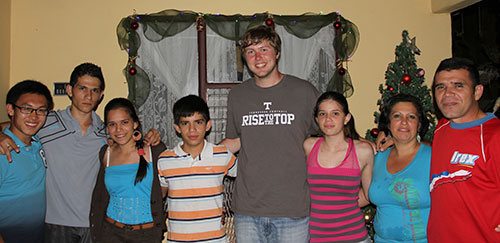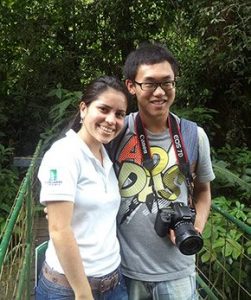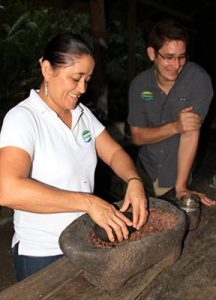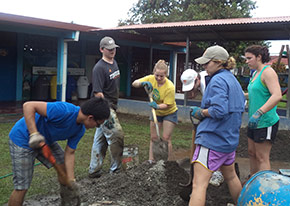Kangmin (Carl) Cheng: Student Report from 2013 Alternative Winter Break in Costa Rica

Looking out the window on the flight and seeing the boundless green, I immediately fell in love with Costa Rica, which is about the size of West Virginia.

In December, this was about the best weather you would expect: sunny, warm and just enough humidity. From the San Jose airport in the town of Alejuela, we took an hour and a half van ride to our final destination: San Miguel de Sarapiqui, a small town with a population about 2,000 people. We drove through suburbs, where houses are only one or two stories and roads are narrow, eventually getting into mountain areas. The air started getting cold but refreshing, and after the sun set,we saw beautiful city lights of San Jose below. Since I barely even know a few words in Spanish and my host family spoke no English, it was really difficult for us to communicate for the next seven days. But that didn’t keep me from having a fantastic experience there and we did carry on some really meaningful conversations.

The next morning we took a tour of Mi Cafecita, a local coffee plantation. I got to know how coffee is made step by step and hiked through the plantation. Heylin was our tour guide and she actually spoke English! After lunch at the plantation, we decided to go on a chocolate tour which was in nearby La Virgen. We walked across a long, swinging, suspension bridge and through a rain forest to get the cocoa table. Once there, the tour guide and naturalist told us about the history of the cocoa bean and its byproducts. We made hot cocoa drinks by hand, and tasted roasted cacao beans. On the way back we saw bullet ants and they are absolutely massive because they are the size of bullets. The next morning we set off for the Poaz Volcano. We drove about an hour up the mountainside to get there. The volcano was unfortunately covered over in fog and we could not get a good look at the crater. It was a little frustrating. In the afternoon we spent time in souvenir shops and had a typical lunch in a Costa Rican restaurant.
On Monday, we started working on our project, which was to build a long concrete bench at a local elementary school. We worked most of the day on this for the next four days. Before we started the project, Kevin, a seven-year-old student at the school, gave us lesson about Costa Rican birds.
In order to build the bench, we had to excavate a hillside and move the soil to another location. No power tools were available, so the whole digging process was slow and incredibly exhausting. We had six shovels, a mattock, several buckets and a wheelbarrow to accomplish this process. Rain poured down on us for over 50% of our time there; however, even in this extreme weather condition, we did not quit working.

All of us actually seemed to be fine working in the rain and Payton told us how she loves running in the rain. On Tuesday before work, we went to a butterfly garden and had some delicious pumpkin ice cream at the home of one of the teachers from the school. After working, we visited a natural hot spring located beside a river. It was a pretty view and for the next two hours, I stayed there and enjoyed every second of it. The water was so nice and warm, just hot enough to relax my muscles and nerves.
On Wednesday, we started to mix concrete. Jonathan and I went to search for wood boards to hold the concrete while others hauled in sand and rocks for mixing concrete. We learned about concrete as the project went along; none of us had worked with it before. We added drink bottles to the concrete to save materials and to be environmentally friendly. Costa Ricans use this type of “filler” instead of gravel, as we would use here in the US.
After the previous day’s minor confusion, we all had a sense of how much of each ingredient to mix, so we sped up the process and used all the materials we had. There was an international bicycling competition coming through the town, and the contestants rode right past the school. After cleaning up and finishing the project, we decided to go on a river adventure. We climbed rocks and hiked down the river to a cliff overlooking a “swimming hole.” There was a platform about thirty-five to forty feet high, and we did cliffing diving! It was my first experience and I was a little nervous at the beginning. I accomplished another goal in my checklist. I did this four times and the water was not super cold. Overall it was a lot fun.
I want to spend a paragraph just to write about the host family we stayed with. They are a wonderful family and super nice people. Although communication was an issue, it did not prevent us from getting to know each other and having a good time. We played UNO with the girls and I played basketball with my Costa Rican brother Emanuel, a fan of American football. The night before we left my host mother said that, “if you ever come back to Costa Rica, this is your family and you can stay here.”
Friday morning we packed our gear, said goodbye, and got in the van to the airport. After a two-hour ride and views of the beauty of Costa Rica’s natural sights, we arrived the airport. Our plane arrived at our first stop, Houston. I got detained at Immigration and Customs, which was not the first time. But, I finally got home the next day.
Costa Rica was a fantastic experience for me and I will always remember this trip. Many thanks to Judith Mallory and other members of the trip. I hope that one day I can go back with the ability of speaking Spanish to explore more about this country, and I recommend you go, too, to experience the culture and beauty of Costa Rica.